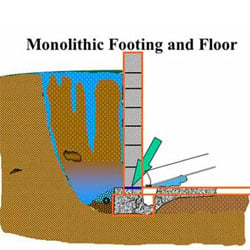Basement Wall & Basement Floor TypesWhat Type of Basement Do You Have? |
|
 |
 |
|
Poured concrete walls will typically leak at the joint between the floor and wall. As the exterior footing drain clogs and hydrostatic pressure builds up against your basement wall, that water will force its way through to your home in the path of least resistance. In this case, that’s the floor-wall joint. Concrete walls can take as much as ten years to finish shrinking and curing. As this curing process completes, the shrinking can create cracks along the walls. These cracks can only get worse, and some of them will leak water into the basement. |
Like poured concrete walls, block walls will leak at the joint between the footing and wall (located at the bottom of the first block). Block wall foundations are also filled with mortar joints that can weaken and leak, and the block itself can crack and allow water to leak through. Block walls are hollow inside, with big boxy chambers inside of each one. Once water enters, it fills these hollow cores, and water leaks in through the mortar joints and the floor-wall joint. This water can sit and collect inside of the concrete, filling up to the point where the water is leaking in from outside the wall. |
 |
 |
|
Stone walls have large areas of irregular spaces spread through various points and at different elevations off the floor. Water can seep through at many different elevations and joints and run down the wall to the floor. When the exterior footing clogs, water buildup is likely to make it through the walls. Because of this, a wall drainage system is required to address the leaking wall problem. |
With clay tile walls, water can make its way from the backfill into your basement at the footing-wall joint (which is the bottom of the first clay tile) and also through the mortar joints. In some cases, water can also leak through the clay tiles themselves. A clay tile wall is one big honeycomb of air spaces. Once the water enters, it fills the hollow core of the clay tiles. As this water builds up, it leaks in through the mortar joints and the floor-wall joint. |
 |
 |
|
A monolithic footing and floor refers to a foundation floor and footing that’s been poured in a single piece. In other words, the floor IS the footing! Water problems for a foundation with a monolithic footing and floor are similar to the ones facing a poured concrete foundation. Water most commonly enters through the floor-wall joint and through cracks in the walls. Monolithic foundations have also been known to be built with block walls. Because the floor and foundation are the same thing with a monolithic floor, any type of system requiring jack hammering a channel to put a sub-floor drain in is not an option. Doing so would remove 30% of the footing and crack the remainder, causing serious structural concerns. The only way to properly create a perimeter waterproofing drainage system in a situation like this is to install an above floor system. |
The space underneath your basement floor is also backfilled when the foundation is laid and can also fill with water. This happens when water travels through the floor-wall joint and under the footing of the foundation and underneath your floor. Water can also follow a sewer or water pipe under the floor. Water will still pool against the side walls as well, and the weight of all that water is working on pushing the water under the floor upwards into your basement. If you have cracks in your basement floor, this water can push up through the floor cracks and cause pooling in your basement. This water can most easily be intercepted at the floor-wall joist with a perimeter waterproofing system and a sump pump. If there is an especially problematic crack on your basement floor, a lateral line can be run from the crack to the perimeter waterproofing system to keep it under control. |
|
Water may enter the basement differently based on your wall type. That's one of the reason, a system design specialist has to come to the actual location to determine the cause of water leakage and offer effective solutions to stop future water leaks. So contact your local dealer today for a free basement wall inspection. [Continue to next slide: Ineffective Drainage][Sign up for a FREE inspection] |
|
Looking for a price? Get a no cost, no obligation free estimate.